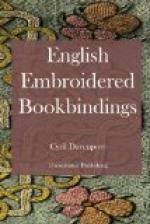Cases for Embroidered Books.
Common though the small satin embroidered books must have been in England during the earlier part of the seventeenth century, it is still certain that the finer specimens were highly prized, and beautifully worked bags were often made for their protection. These bags are always of canvas, and most of them are decorated in the same way, the backgrounds of silver thread with a design in tapestry-or tent-stitch, and having ornamental strings and tassels. To describe one of these is almost to describe all. The best preserved specimen I know belongs to a little satin embroidered copy of the Psalms, printed in London in 1633, and measures 5 inches long by 4 inches in depth.
[Illustration: 1—Embroidered Bag for Psalms. London, 1633.]
The same design is repeated on each side. A parrot on a small grass-plot is in the middle of the lower edge. Behind the bird grow two curving stems of thick gold braid, each curve containing a beautifully-worked flower or fruit. In the centre is a carnation, and round it are arranged consecutively a bunch of grapes, a pansy, a honeysuckle, and a double rose, green leaves occurring at intervals. From the lower edge depend three ornamental tassels of silver loops, with small acorns in silver and coloured silks, one from the centre and one from each corner.
The top edge has two draw-strings of gold and red braid, each ending in an ornamental oval acorn of silver thread and coloured silks, probably worked on canvas over a wooden core, ending in a tassel similar to those on the lower edge.
A long loop of gold and silver braid serves as a handle, or means of attachment to a belt, and is fixed at each side near a strong double loop of silver thread, used when pulling the bag open. The lining is of pink silk. This particular bag is perfect in colour as well as condition, but usually the silver has turned black, or nearly so. Besides these very ornamental bags, others of quite simple workmanship are occasionally found, worked in outline with coloured silks. As well as the embroidered bags, certain rectangular cloths variously ornamented, some richly, some plainly, were made and used for the protection of embroidered books, when being read. These, like the bags, only seem to have been used during the seventeenth century. A particularly fine example belongs to a New Testament bound in embroidered satin in 1640. It is of fine linen, measuring 16-1/2 by 9-1/4 inches, and is beautifully embroidered in a floral design, with thick stalks of gold braid arranged in curves and bearing conventional flowers and leaves, all worked in needle-point lace with coloured silks in a wonderfully skilful manner.




